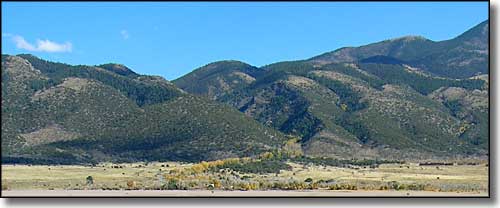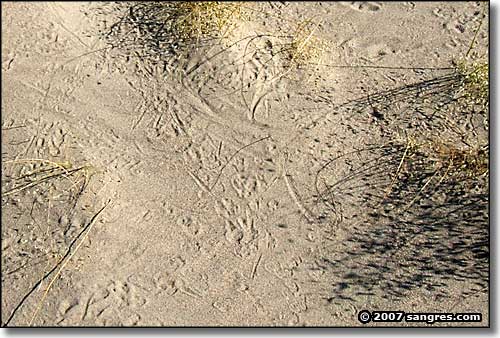
Great Sand Dunes National Park and Preserve
Ongoing Research

The valley of Mosca Creek, from the dunes
The recent expansion into a national park and preserve was based on extensive scientific research, leading to the protection of an entire geological and hydrological system. Today, research is vital to sound management of this newly complex park. Here are descriptions of a few of the research projects that were underway in 2005. Ask at the Visitor Center for more information on current projects.
Benthic Macroinvertebrates - A survey for these tiny aquatic creatures is underway in the Sand Creek drainage. This is the first of many surveys investigating the possibility of reintroducing the native Rio Grande cutthroat trout into the drainage. In 2005, the survey began early in the year, as researchers were interested in targeting species which were active during the late winter as iced-over streambeds began to open.
Vegetation Mapping - The National Park Service has a service-wide undertaking in inventorying the biological components of the natural parks. One of the more ambitious projects beginning during 2005 is mapping the vegetation communities and structures in and around the Great Sand Dunes.
The Great Sand Dunes project is quite ambitious because it will include not only the national park itself, but other area agency - and privately - managed lands as well.
Using aerial photography and/or satellite imagery, photo interpreters will determine the types of vegetation communities indicated by certain light spectrum “signatures” on the images. Field biologists will then go directly to sites randomly chosen from the images to confirm the accuracy of the interpreted “signatures.”
The results will provide both agency and priate land managers with information on the types of vegetation communities in the area, helping them to monitor long-term changes on those lands as well as make educated decisions regarding grazing, fire management and recreational uses.
Elk/Bison Study - Another very large-scale, multi-year project focuses on the interactions of elk and bison on plant communities at Great Sand Dunes and the surrounding areas. While very complex, there are three main components and expected results:
- The establishment of several “vegetation exclosures” that will exclude grazing animals. Researchers will compare the plant communities in absence of the animals with those areas that are regularly grazed.
- Several individual elk and bison have been collared with electronic tracking devices, allowing researchers to follow these animals at least once per week throughout the duration of the project. This provides information to researchers about where the elk and bison are moving, which areas they prefer during different seasons, how long they stay in each area, what vegetation they favor, and whether the individuals are attached to a certain group or population of animals.
- Determine elk population size and dynamics. A component of this study is to determine the number of elk present in and around Great Sand Dunes, their reproductive and survival rates, and whether they function as one herd or several individual herds. An estimated 6,000 elk are believed to inhabit the grasslands in the survey unit.
This research will provide the National Park Service, the Colorado Division of Wildlife, the Fish and Wildlife Service, and the Nature Conservancy with the information needed to effectively manage the large mammal populations here.
White Pine Blister Rust - Research to determine the presence and distribution of non-native White Pine Blister Rust (WPBR) at Great Sand Dunes and the surrounding areas began summer 2004 and is continuing in 2005. WPBR was introduced into North America from Asia via Europe during the early 20th century. While trees in Europe will often survive this disease, the trees in North America do not have any natural defenses against it.
WPBR was first discovered at Mosca Pass in 2003, having apparently become established there between 10-20 years ago. It is unknown from where the disease came, but the fungal spores that spread the disease are wind-borne. While death from this disease can take 10 or more years, it is always fatal for the tree. Many of the limber and bristlecone pine trees found in the montane forest at Great Sand Dunes exceed 1,000 years of age. These trees are found at higher elevations (9,000 to 10,500 feet) in the park and surrounding areas, and form a very important component of the montane forest system.
The research is designed to determine the extent of the disease, the types of trees it affects and the susceptibility of individual trees to the disease. Although answers to fighting this disease are many, many years away, this information will enable researchers to begin to address possible methods of plant resistance to the disease.

Great Sand Dunes, from the Zapata Falls area
Geomorphology Studies - New research into the surficial features of the valley are shedding light on the formation of the dunes, and conditions when people first lived here. Research continues into an apparent crater to see if it is meteoric in origin.
Sand and Water Dating - A new technique, still under development, tries to date sand samples from various depths in the dunes. Dates from ancient to recent are being revealed by water dating of the spring waters in and around the dunes.
Seismographic Station - A station was installed in 2004 to monitor subsurface movement in the region.
Archeological Surveys - This major project began a few years ago, funded by the Smithsonian, the Colorado Historical Society and Friends of the Dunes. The focus now is on newly acquired areas.
Ethnographic Survey - A part of the archeology project, tribes are interviewed for information about historic use of the dunes area.
Courtesy Phyllis Pineda Bovin, National Park Service Biologist, Great Sand Dunes

So many beasties...
Large Visitor Center Area Map - Full National Park Map
Great Sand Dunes Pages:
Great Sand Dunes Index Page - Photo Gallery - Maps - Trails to Explore
Geology FAQ - Great Sand Dunes Partners
